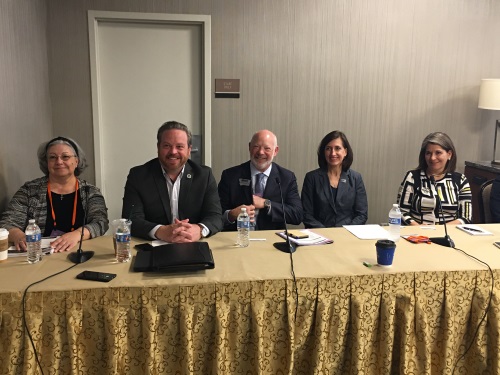Partnerships between state departments of transportation and federal, local, and tribal agencies – among other stakeholders – are critical to addressing a variety of mobility challenges across the country.
[Above photo by AASHTO]
That’s according to a panel of state DOT and local government executives convened during the American Association of State Highway and Transportation Officials 2022 Spring Meeting in New Orleans.

Moderated by Victor Bonett, senior manager of public policy at Amazon, panel participants described how states, regional planning commissions, and municipalities are addressing transportation challenges and finding solutions together in order to reach “shared goals” such as ensuring equity among transportation facilities and resources, expanding broadband internet access, and establishing a national electric vehicle re-charging network.
“Transportation projects offer us an opportunity to rebuild local streets, multi-use trails, and reconnect neighborhoods to downtown areas,” noted Monique Boulet, CEO of Louisiana’s Acadiana Planning Commission.
“Local partnerships help connect projects better with local communities – letting us walk through the tough questions and listen to what really matters to residents,” she explained. “It means using ‘non-traditional’ approaches to gather community input, holding events at churches and working with local pastors. We spend a lot of one-on-one time with them; they are critical to effective communications with affected constituencies. Finding such ‘trust spots’ is critical.”
Nancy Daubenberger, interim commissioner and chief engineer with the Minnesota Department of Transportation, noted that such “local connections’ encompass more than just transportation construction concerns.

“We established a local partnership program or LPP to help improve the state highway system – to identify where we needed improved turn lanes, roadway lighting, traffic signals, pedestrian tunnels, and sidewalks,” she said. “Local partnerships are also key to our master maintenance agreements – to define responsibilities for snow control, vegetation management, pavements markings, fencing, draining, litter control, etc.”
Diane Gutierrez-Scaccetti, commissioner of the New Jersey Department of Transportation, emphasized that “partnerships” and “stakeholders” now come in a variety of shapes and sizes compared to the past.
“They may be a trucking company that needs better freight access, or a school searching for a way to improve walking and biking access,” she said. “Demand today for pedestrian services is extraordinarily important to our communities and is only growing.”
[Editor’s note: AASHTO’s Transportation TV recently profiled the New Jersey DOT as part of its ‘2 Minute State DOT Update’ video series.]
Gutierrez-Scaccetti pointed out that deeper engagement with local municipalities and county administrators is critical in another way for state DOTs.
“We know transportation projects take time to build – but many communities don’t understand that. That is another reason why engagement so critical. We are also now changing up our budgeting cycle to better align with municipal and county budgeting schedules so they can apply for and use state funding more effectively.”
Chris Barnett, the supervisor for the Orion Township in Michigan, emphasized that localities like his are also trying to broaden their focus – especially when it comes to transportation issues.
“We are all about regionalism now, especially on transportation,” he explained. “That helps us better assess what we need to work on, such as non-motorized transportation – pinpointing the benefits of bike lanes, sidewalks, and crosswalks.”
Barnett added that a small positive aspect to the COVID-19 pandemic is that it broadened the ability of the public to engage on transportation discussion, especially through virtual meetings and the digital dissemination of information.
“For example, almost everyone knows how to use QR codes now – that makes the dissemination of information easier,” he said.

In the end, that is why Malcolm “Mack” Long – director of the Montana Department of Transportation – described state DOTs as “builders” in their respective areas.
“We like to say we are the builders because we build the connections that bring communities together,” he said.
“Our district administrators are our eyes and ears on the ground – for example, they go to diners for breakfast in the mornings, to get input from our residents. That includes outreach to tribes in our state as well. Everyone has different views of transportation needs and it is an interesting balancing act to bring all of it together.”



